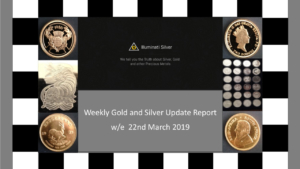
Gold rose $12 last week from $1301 to $1313 having hit a high of $1,320 and a low of $1,298. In sterling terms gold finished the week at £994 that’s up £15, and in Euros it closed at 1,161 Euros that’s up 13 euros.
Silver rose 13 cents; from $15.29 to $15.42; having hit a high of $15.63 and a low of $15.23. In sterling terms, it closed at £11.67, that’s up 17 pence and in Euros it closed at 13.64 euros, that’s up 0.14 euros.
The Gold to Silver Ratio remained unchanged at 85.1:1
The Dow Jones closed on Friday at 25,502, down 460 points on the day and down 346 points on the week, and the NASDAQ closed at 7,642, down 169 points on the day and down 46 points on the week, and the S&P 500 closed at 2,800 down 54 points on the day and down 22 points on the week.
Brent Crude fell just 13 cents, from $67.16 to $67.03 and US Light Crude rose 52 cents, from $58.52 to $59.04
The dollar index remains almost unchanged and stands at 96.55 that’s down just 0.04 on the week.
Our conclusion in last weeks report stated:
“there will be some volatility prior to the FED’s announcement on Wednesday though we would expect sentiment to be marginally more positive for gold and silver prices than negative”.
Indeed, the FED announcement on Wednesday was more dovish than expected; by suggesting that there will be no more rate hikes for 2019; thereby causing the price of gold and silver to rise late on Wednesday and well into Thursday – and we have produced a video for Inner Sanctum members on this issue which is being uploaded to the website later today.
Although the US dollar strengthened again a little on Friday, and the Euro declined – the result of poor European economic data – has enabled gold to remain buoyant.
Technical analysts acknowledge that support is seen near the 50-day moving average of $1305 and momentum has turned positive as the MACD line crosses the MACD signal line.
Add to this the PMI data released on Friday in Europe showing German and French Manufacturing and Services PMI’s falling, suggest that Europe may be heading for a recession.
All that said, gold is still finding that resistance level of $1325 extremely difficult to reach, and it is generally accepted that only when gold surpasses this level, and holds for a day or two, is it likely to continue its upward journey towards $1400.
Silver moved similarly to gold last week, and the general consensus is that it will continue to prove quite choppy within the $15 – $15.50 band and only when we see a breakout in either direction from these levels can we determine the longer-term trend for the precious metal.
It is not revolutionary for us to point out that any reduction in activity in the global economy will adversely affect the demand for silver as an industrial metal, and this then has to be counterbalanced by a more significant rise in silver demand as a monetary metal, if we are to see prices move much higher; and this is the quandary this market is currently experiencing, and the difficulty many traders have when attempting to assess silver’s price and price movements during the coming months.
Our view is perhaps a little more pessimistic than most, if only because although the US economy is far from wonderful, it is better positioned, at least for the moment, than Europe, the UK and a number of other industrial economies all of which serves to maintain dollar strength though one would normally expect its relative value to fall.
This is truly a key message, and one with which we use with some accurate effect against the pumpers who keep telling us that the dollar is on the verge of collapse – collapse against what? A weaker Sterling, Euro, Australian dollar etc? and the Chinese Yuan which has had its value downgraded so frequently in the past few years many countries are crying foul – currency manipulation.
Let’s please not lose sight of this economic reality – this is why gold and silver have risen in sterling, euro, Yuan, Australian dollar terms when it has little moved in comparison in US dollar terms.
So, what do we have on the economic calendar for next week:
- Tuesday – Consumer Confidence Figures for March
- Wednesday – Trade deficit for January
- Thursday – GDP revision for Q4
- Friday – Consumer spending and core inflation for January, Personal income for and New home sales for February and the Consumer sentiment index for March.
The core inflation and consumer spending figures for February have been delayed.
So, in conclusion, we do not see anything particularly exciting on the economic front for gold and silver prices next week, save that they will continue to move more or less rangebound as mentioned in previous weeks.
On the political front however, there may be a slight impact, as the Mueller Report has been submitted to the Department of Justice which has promised to advise Congress of the main findings this weekend and of course there will be continual discussion and political activity and reactions for the next couple weeks, which may prove either positive or negative for markets depending on the Report’s findings.


Leave A Comment
You must be logged in to post a comment.